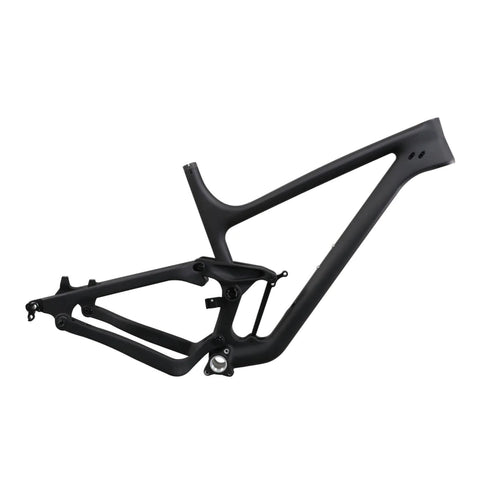This article provides a guide for choosing the right mountain bike frame. The three types discussed are cross-country, trail, and enduro frames.
It can be overwhelming to navigate through all the options when buying a mountain bike or upgrading your existing one. Especially if you're new to the sport, the technical terms can be confusing and difficult to understand. It's important to consider many factors before making a decision, and this can make the process seem even more daunting.
Cross-country, trail, and enduro bikes are each designed for a specific type of terrain, and the frame of each bike is tailored to put the rider in the optimal position for that type of riding. In this blog post, we'll compare the differences between these frames and discuss what each type of bike is best used for.
The bike's components are hand-picked to enhance the frameset of each specific frame type. However, it's important to note that there is some overlap between components, and every bike frame has its limitations. There's no such thing as a perfect bike, but you can customize it to make it feel perfect!
It's important to note the difference in geometry between different types of bike frames. While it might not be as apparent as the amount of travel the rear shock allows or the wheel size that can be accommodated, it serves a purpose. Geometry is responsible for how you sit on a bike and how a bike handles. It affects aspects such as steering, control when descending on technical terrain, ease of climbing, and the bike's ability to maintain speed.
Another point to consider is the travel a bike frame offers. A cross-country bike frame will have less travel than an Enduro frame.
Which MTB frame is right for you?
1. Cross country frame (also known as XC)
Cross-country rides for most recreational riders mean long journeys on non-technical tracks and open-fire roads, testing endurance, bike handling, and skills.
The geometry of a cross-country frame is designed to be as efficient as possible, with a shorter wheelbase, a shorter reach, and a steep seat tube angle. This results in a more aerodynamic position for the rider, allowing them to put maximum power down. Additionally, the shorter wheelbase and steep headtube angle make the bike more nimble and improve its climbing capabilities. It's worth noting that the chainstay on these frames is relatively longer compared to the shorter wheelbase.
An XC-frame is designed to be lightweight; high-end models weigh about 8 to 9 kilos. These frames are made from specific materials to ensure they are as light and stiff as possible. Carbon is a common material used for XC frames. The stiffness of the bike contributes to the pedal efficiency. This is why many cross-country bikes are hardtails.
Full-suspension XC frames have become more popular in recent years, even among professional racers. Although the rear shock adds some weight and sacrifices stiffness, it improves comfort significantly. The rear suspension, with 100mm to 120mm of travel, enhances the bike's descending capabilities.
All components are chosen for speed, weight, and efficiency when building a full XC bike. This includes lightweight 29-inch wheels with fast-rolling tires, a relatively short handlebar for maneuverability, and a lightweight drivetrain.
Our new S3 frameset will be a good choice if you're looking for an XC-bike.
2. Enduro bike frame
The Enduro bike frame is designed for downhill riding, whereas the cross-country bike is built for climbing. During an Enduro race, only the downhill section of the course is timed, and the course also includes liaison stages on some of the most difficult trails.
Compared to an XC-frame, an Enduro-frame has a longer wheelbase that provides:
- Greater stability.
- A slacker headtube angle for better handling on the downhills.
- A longer reach that offers a more aggressive riding position.
All Enduro bikes have full suspension and rear travel that ranges from 140mm to 180mm.

An enduro bike frame typically features more sturdy components than an XC bike, including larger brakes that can provide up to 200mm of stopping power. The bike's rims can be either 27.5 or 29 inches in size or a combination of both, with wide tires that provide enhanced grip and control.
A dropper seat post is standard on enduro bikes, allowing riders to move more freely while descending. The handlebars are also wider, providing even more control.
3. Trail bike frame
The trail bike is an all-rounder of mountain bikes between the cross country and enduro-bike. It’s right at home on technical climbs and capable of heavy descends, but it doesn’t excel.
When we look at the geometry of the trail frame, you’ll also notice it’s “in-between”, to be as versitile as possible. It has a longer wheelbase, but not as long as an enduro bike; the headtube and seat tube angle are a bit slacker than an XC-bike. This gives the bike a perfect mix of control and comfort. Most trail frames will be full suspension with travel between 120mm and 150mm for extra comfort.
Depending on the manufacturer, a trail bike can lean more towards the cross-country or enduro sides. This bike is a perfect fit for the recreational rider looking to get the best of both worlds. We have just what you need if you want a reliable and pedal-friendly trail bike.
Final:
Choosing the right bike is a difficult decision that ultimately rests with you. It is important to consider the riding you plan to do, the terrain, your riding style, and your preferences. Even after you have built your dream bike, you can fine-tune the feeling with slight adjustments such as changing the tire pressure, width, handlebar width, stem, or even the rebound on your forks. We hope that this blog has assisted you in making the best decision for your needs.




